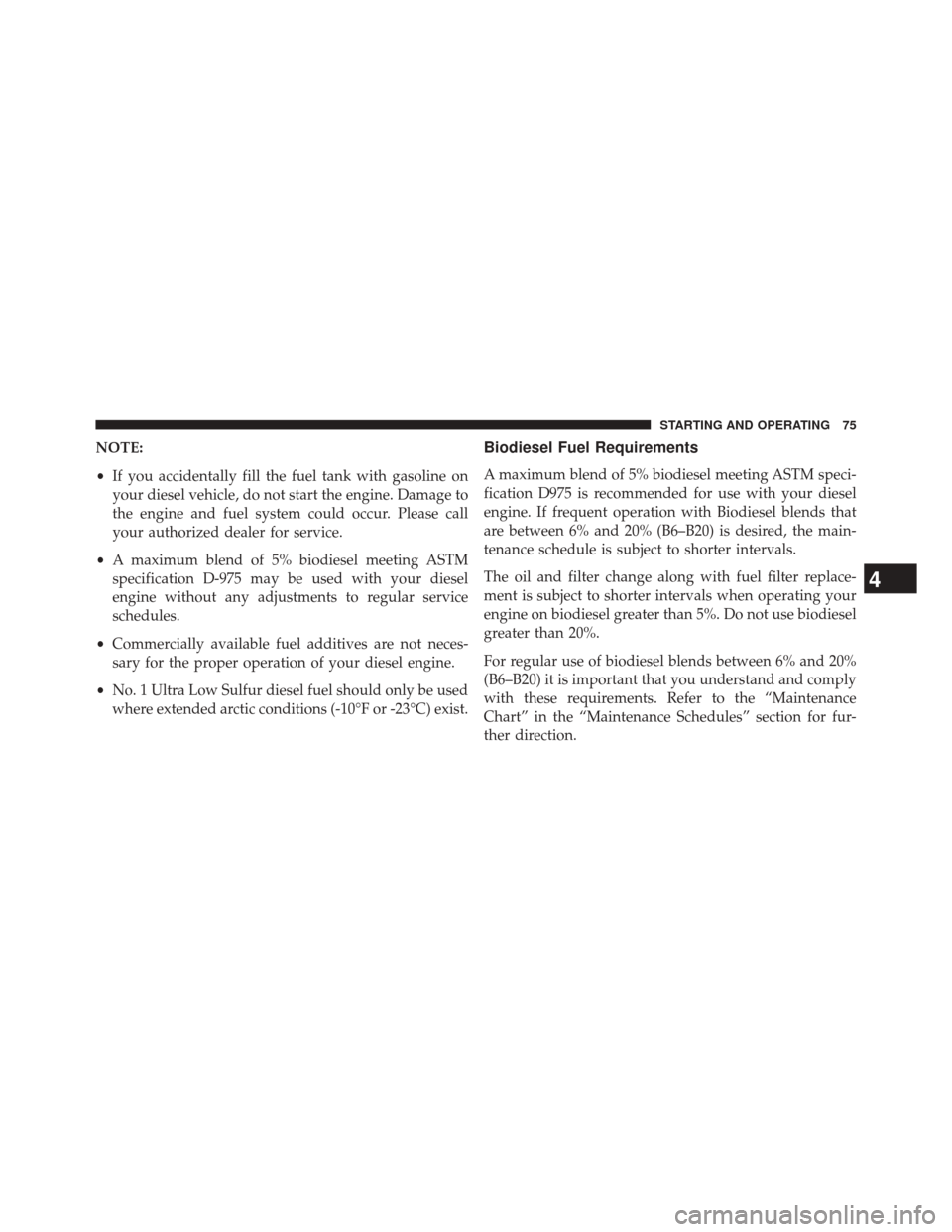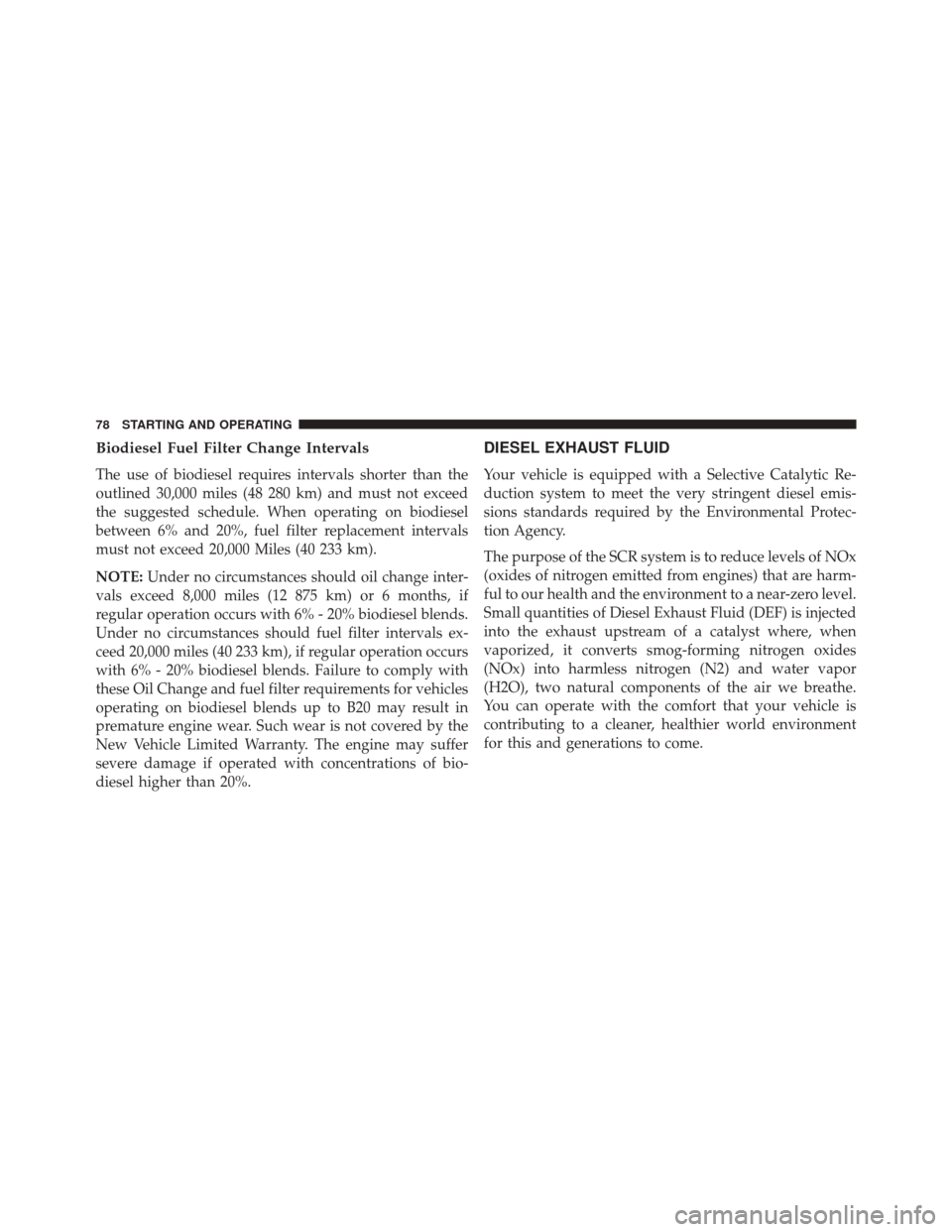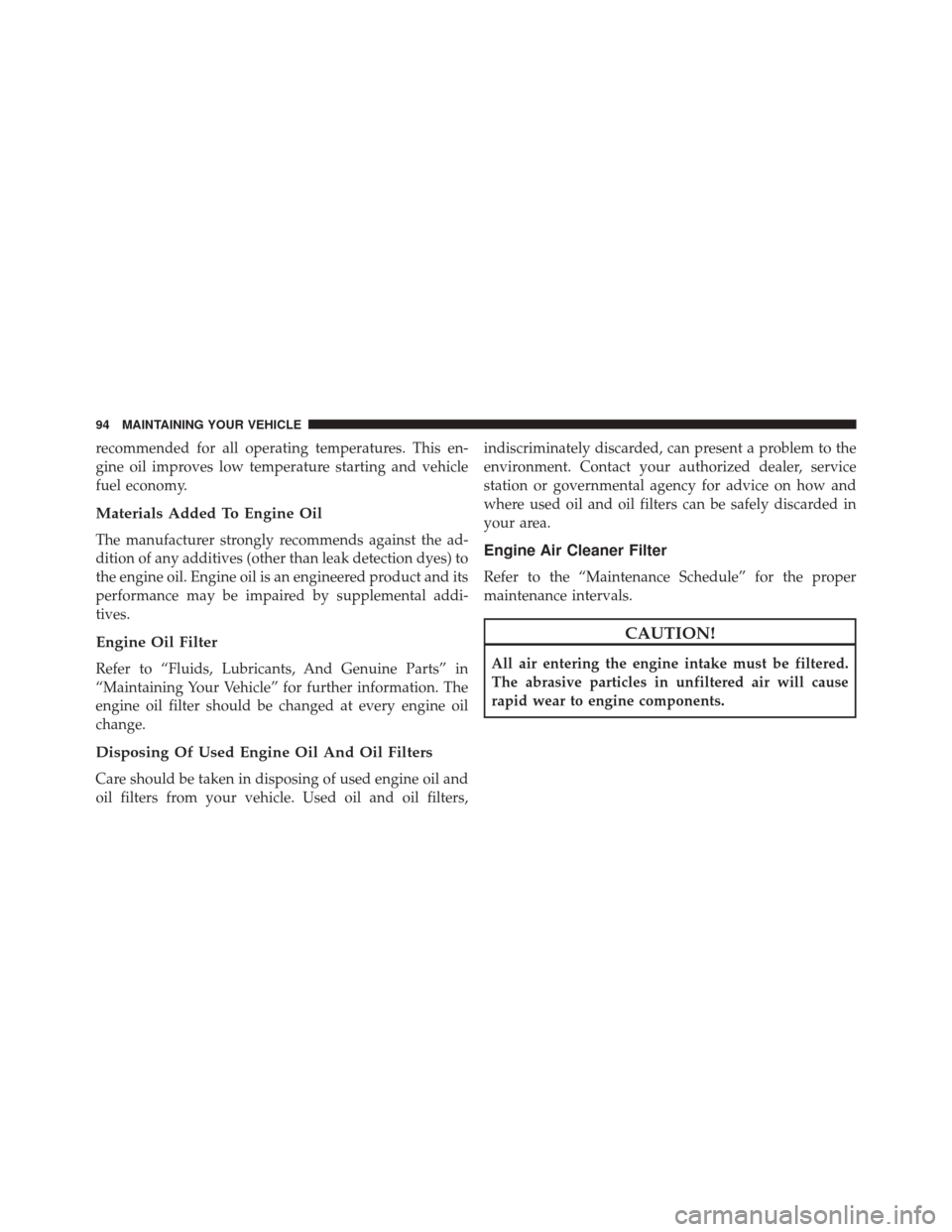Page 77 of 338

NOTE:
•If you accidentally fill the fuel tank with gasoline on
your diesel vehicle, do not start the engine. Damage to
the engine and fuel system could occur. Please call
your authorized dealer for service.
• A maximum blend of 5% biodiesel meeting ASTM
specification D-975 may be used with your diesel
engine without any adjustments to regular service
schedules.
• Commercially available fuel additives are not neces-
sary for the proper operation of your diesel engine.
• No. 1 Ultra Low Sulfur diesel fuel should only be used
where extended arctic conditions (-10°F or -23°C) exist.Biodiesel Fuel Requirements
A maximum blend of 5% biodiesel meeting ASTM speci-
fication D975 is recommended for use with your diesel
engine. If frequent operation with Biodiesel blends that
are between 6% and 20% (B6–B20) is desired, the main-
tenance schedule is subject to shorter intervals.
The oil and filter change along with fuel filter replace-
ment is subject to shorter intervals when operating your
engine on biodiesel greater than 5%. Do not use biodiesel
greater than 20%.
For regular use of biodiesel blends between 6% and 20%
(B6–B20) it is important that you understand and comply
with these requirements. Refer to the “Maintenance
Chart” in the “Maintenance Schedules” section for fur-
ther direction.
4
STARTING AND OPERATING 75
Page 79 of 338

Fuel Quality — Must Comply With ASTM
Standards
The quality of Biodiesel fuel may vary widely. Only fuel
produced by a BQ9000 supplier to the following specifi-
cations may be blended to meet Biodiesel blend B6 – B20
fuel meeting ASTM specification D-7467:
•Petrodiesel fuel meeting ASTM specification D-975
and Biodiesel fuel (B100) meeting ASTM specification
D-6751
Fuel Oxidation Stability — Must Use Fuel Within
Six Months Of Manufacture
Biodiesel fuel has poor oxidation stability which can
result in long term storage problems. Fuel produced to
approved ASTM standards, if stored properly, provides
for protection against fuel oxidation for up to six months.
Fuel Water Separation — Must Use MOPAR
Approved Fuel Filter Elements
Biodiesel fuel has a natural affinity to water and water
accelerates microbial growth. Your MOPAR filtration
system is designed to provide adequate fuel water sepa-
ration capabilities.
Fuel In Oil Dilution — Must Adhere To Required
Oil Change Interval
Fuel dilution of lubricating oil has been observed with
the use of Biodiesel fuel. Fuel in oil must not exceed 5%.
To ensure this limit is met your oil change interval must
be maintained with in the suggested schedule. The
regular use of biodiesel between 6% and 20% requires
intervals shorter than the outlined 10,000 miles and must
not exceed the suggested schedule. When routinely op-
erating on biodiesel between 6% and 20%, oil and filter
replacement intervals must not exceed 8,000 Miles or
6 months, which ever comes first.
4
STARTING AND OPERATING 77
Page 80 of 338

Biodiesel Fuel Filter Change Intervals
The use of biodiesel requires intervals shorter than the
outlined 30,000 miles (48 280 km) and must not exceed
the suggested schedule. When operating on biodiesel
between 6% and 20%, fuel filter replacement intervals
must not exceed 20,000 Miles (40 233 km).
NOTE:Under no circumstances should oil change inter-
vals exceed 8,000 miles (12 875 km) or 6 months, if
regular operation occurs with 6% - 20% biodiesel blends.
Under no circumstances should fuel filter intervals ex-
ceed 20,000 miles (40 233 km), if regular operation occurs
with 6% - 20% biodiesel blends. Failure to comply with
these Oil Change and fuel filter requirements for vehicles
operating on biodiesel blends up to B20 may result in
premature engine wear. Such wear is not covered by the
New Vehicle Limited Warranty. The engine may suffer
severe damage if operated with concentrations of bio-
diesel higher than 20%.
DIESEL EXHAUST FLUID
Your vehicle is equipped with a Selective Catalytic Re-
duction system to meet the very stringent diesel emis-
sions standards required by the Environmental Protec-
tion Agency.
The purpose of the SCR system is to reduce levels of NOx
(oxides of nitrogen emitted from engines) that are harm-
ful to our health and the environment to a near-zero level.
Small quantities of Diesel Exhaust Fluid (DEF) is injected
into the exhaust upstream of a catalyst where, when
vaporized, it converts smog-forming nitrogen oxides
(NOx) into harmless nitrogen (N2) and water vapor
(H2O), two natural components of the air we breathe.
You can operate with the comfort that your vehicle is
contributing to a cleaner, healthier world environment
for this and generations to come.
78 STARTING AND OPERATING
Page 91 of 338
MAINTAINING YOUR VEHICLE
CONTENTS
�ENGINE COMPARTMENT — 3.0L DIESEL .....90
� MAINTENANCE PROCEDURES ............91
▫ Engine Oil ...........................92
▫ Engine Air Cleaner Filter ................94
▫ Draining Fuel/Water Separator Filter ........97
▫ Underbody Mounted Fuel Filter Replacement. .100
▫ Priming If The Engine Has Run Out Of Fuel . .101
▫ Intervention Regeneration Strategy — Message
Process Flow ....................... .103▫
Maintenance-Free Batteries ..............103
▫ Cooling System ..................... .104
▫ Charge Air Cooler — Inter-Cooler .........110
▫ Brake System ........................110
� FLUID CAPACITIES ....................113
�
FLUIDS, LUBRICANTS AND GENUINE PARTS . . .114
▫ Engine .............................114
▫ Chassis ............................118
5
Page 92 of 338
ENGINE COMPARTMENT — 3.0L DIESEL
1 — Air Cleaner Filter5 — Battery
2 — Engine Oil Dipstick 6 — Power Distribution Center (PDC)
3 — Engine Oil Fill 7 — Washer Fluid Reservoir
4 — Brake Fluid Reservoir 8 — Engine Coolant
90 MAINTAINING YOUR VEHICLE
Page 95 of 338

mark. The total capacity from the MIN mark to the MAX
mark is 1.3 qts (1.2 L).
CAUTION!
Overfilling or underfilling the crankcase will cause
oil aeration or loss of oil pressure. This could damage
your engine.
NOTE: It is possible for your oil level to be slightly
higher than a previous check. This would be due to diesel
fuel that may temporarily be in the crankcase due to
operation of the diesel particulate filter regeneration
strategy. This fuel will evaporate out under normal
operation.
Never operate the engine with oil level below the “MIN”
mark or above the upper “MAX” mark.
Change Engine Oil
Refer to the “Maintenance Schedule” for the proper
maintenance intervals.
Engine Oil Viscosity (SAE Grade)
CAUTION!
Your vehicle is equipped with an advanced technol-
ogy Diesel Engine and an emission device designed
to limit Diesel Particulate Emissions from being
released into the atmosphere. The durability of your
engine and life expectancy of this diesel particulate
filter emission device is highly dependent on the use
of the correct engine oil.
Only use ACEA C3 SAE 5W-30 Synthetic Low Ash engine
oil meeting FCA Material Standard MS-11106 or Pennzoil
Ultra Euro L full synthetic 5W-30 motor oil, which is
5
MAINTAINING YOUR VEHICLE 93
Page 96 of 338

recommended for all operating temperatures. This en-
gine oil improves low temperature starting and vehicle
fuel economy.
Materials Added To Engine Oil
The manufacturer strongly recommends against the ad-
dition of any additives (other than leak detection dyes) to
the engine oil. Engine oil is an engineered product and its
performance may be impaired by supplemental addi-
tives.
Engine Oil Filter
Refer to “Fluids, Lubricants, And Genuine Parts” in
“Maintaining Your Vehicle” for further information. The
engine oil filter should be changed at every engine oil
change.
Disposing Of Used Engine Oil And Oil Filters
Care should be taken in disposing of used engine oil and
oil filters from your vehicle. Used oil and oil filters,indiscriminately discarded, can present a problem to the
environment. Contact your authorized dealer, service
station or governmental agency for advice on how and
where used oil and oil filters can be safely discarded in
your area.
Engine Air Cleaner Filter
Refer to the “Maintenance Schedule” for the proper
maintenance intervals.
CAUTION!
All air entering the engine intake must be filtered.
The abrasive particles in unfiltered air will cause
rapid wear to engine components.
94 MAINTAINING YOUR VEHICLE
Page 103 of 338

3. Open the water drain valve, and let any accumulatedwater drain.
4. Close the water drain valve.
5. Remove bottom cover using a strap wrench. Rotate counterclockwise for removal. Remove the used o-ring
and discard it.
6. Remove the used filter cartridge from the housing and dispose of it according to your local regulations.
7. Wipe the sealing surfaces of the lid and housing clean.
8. Install a new o-ring into the ring groove on the filter housing and lubricate with clean engine oil.
NOTE: WIF (Water In Fuel) sensor is re-usable. Service
kit comes with new o-ring for filter canister and WIF
sensor.Priming If The Engine Has Run Out Of Fuel
WARNING!
Do not open the high pressure fuel system with the
engine running. Engine operation causes high fuel
pressure. High pressure fuel spray can cause serious
injury or death.
1. Add a substantial amount of fuel to the tank, approxi- mately 2 to 5 gal (8L to 19L).
2. Press ignition switch twice without your foot on brake to put vehicle in Run position. This will activate the in
tank fuel pump for approximately 30 seconds. Repeat
this process twice.
3. Start the engine using the “Normal Starting” proce- dure. Refer to “Starting Procedures” in “Starting and
Operating” for further information.
5
MAINTAINING YOUR VEHICLE 101